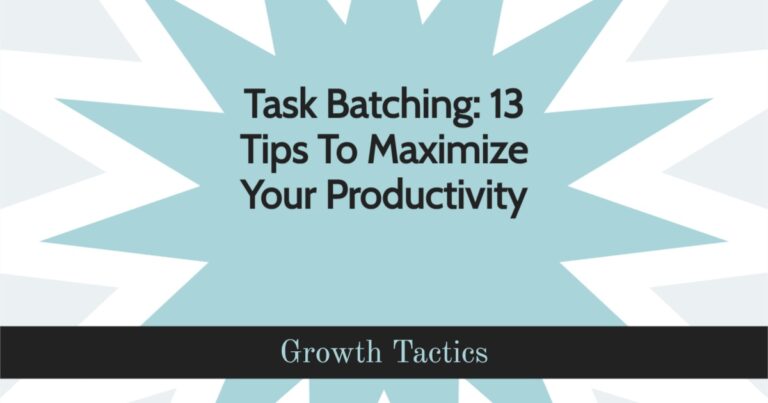Managing your energy levels is an essential part of staying productive throughout the day. When we’re constantly busy and working without taking breaks, we can experience burnout, diminishing returns, and a general decrease in overall productivity. In this guide, we’ll explore some tips and tricks for maintaining high energy levels throughout the day, so you can stay productive and feel accomplished.
Jump To Section
Why Managing Your Energy is More Important Than Managing Your Time
Traditional time management focuses solely on efficiency – how to get more done in less time. But your productivity and success aren’t just about cramming more into each minute. It’s about aligning tasks with your energy levels throughout the day.
Unlike time, your energy isn’t constant. Your energy levels fluctuate based on your body’s ultradian rhythms, which cycle between higher and lower energy every 90 minutes. You have a finite amount of energy each day, and when it runs out, your productivity plummets.
That’s why managing your energy is crucial. Your energy capacity determines what you can accomplish in a day, regardless of how efficient you try to be with your time. Focus on managing your energy – not just your time – if you want to optimize productivity and avoid burnout.
Understand Your Body’s Natural Energy Cycles
Our bodies have natural ebbs and flows of energy throughout the day known as ultradian rhythms. We cycle between periods of higher and lower energy about every 90 minutes.
When we’re in a high-energy period, we feel more focused and productive. During a low-energy period, we feel more sluggish and distracted. The key is to sync your most challenging work tasks with your body’s high-energy rhythms.
Schedule important work like writing, analysis, or creative tasks during your peak energy times. Then use your low-energy periods for easier work like responding to emails, organizing files, or administrative tasks.
Pay attention to when you feel your focus and productivity increasing or decreasing. See if you notice a natural 90-minute cycle. Then align your workday to make the most of your energy peaks and valleys. Managing your energy in tune with your body’s rhythms can help you get more done in less time.
Focus on the Most Important Tasks When Your Energy is High
Our energy levels fluctuate throughout the day. Most people experience a peak in energy and mental sharpness in the morning after a good night’s sleep. Learn to make the most of your energy peaks by focusing on your most challenging and highest-priority tasks during this high-energy period.
Rank your tasks by priority and importance. Make a list of everything you need to accomplish each day and rank the tasks from most to least crucial. Schedule the essential, mission-critical activities for when you know you’ll be at your best. Use your bursts of peak energy for the work that requires the most brainpower and concentration.
Schedule important tasks for when your energy levels are highest. Plan your day so your most demanding cognitive or creative work happens when your energy is at its maximum. For most people, this is first thing in the morning, but you may find you’re sharpest right after lunch or at other times. Identify your prime energy hours and reserve them for tasks that require your best effort and focus.
Use bursts of high energy for challenging work. Know your limits and work in focused sprints during your peak energy periods. Crucial work that demands a lot from you mentally will get done faster and better when you’re operating at full power. Then switch to lighter tasks as your energy starts to dip. Work smart by matching the task to your energy level.
Take Regular Breaks to Recharge
Your energy levels naturally fluctuate throughout the day. Most people can only focus intently on mentally demanding work for 60-90 minute periods before needing a break.
Take a 10-20 minute break every 60-90 minutes to recharge your energy. Get up from your desk, walk around, stretch your legs, and grab a healthy snack or hydrating beverage. Breaks are crucial for realigning your mindset and regaining mental clarity.
Short breaks help re-energize your brain and body, so you can tackle the next task productively. Breaks also provide time for your subconscious to make connections while your conscious mind disengages.
Aim to fully detach from work during breaks. Step away from your computer, put away your phone, and avoid checking emails. Allow your brain to rest from focused concentration.
Brief breaks help you return to work recharged, refocused, and with renewed energy. They boost productivity more than trying to force yourself to power through mental exhaustion. The most effective work happens when you align tasks with your energy levels.
Get Outside for a Quick Energy Boost
Getting outside, even for a short walk, can provide an energizing break when you’re feeling drained at work. Exposure to natural light and fresh air has been shown to boost mood and energy levels.
Taking a 5-10 minute walk outside gets your blood flowing and gives your eyes a rest from staring at a computer screen. It also helps clear your mind so you can tackle the next task refreshed and refocused.
Some easy ways to incorporate outdoor breaks throughout your workday:
- Walk around the block
- Sit outside and eat lunch
- Take a call or read emails outside
- Do walking meetings with colleagues
- Stand outside for a few minutes to get some fresh air
Stepping outside your workplace for even a short time allows you to disengage and gives your brain an opportunity to recharge. A quick dose of sunlight and nature works wonders to lift your energy so you can be more focused and productive when you’re back at your desk.
Set Clear Boundaries Between Work and Life
Setting clear boundaries between your work and personal life is crucial for managing your energy effectively. When work bleeds into your personal time, it can quickly lead to burnout.
To maintain healthy boundaries:
-
Disconnect after work hours. Avoid checking emails or taking work calls once you’re done for the day. Have a set end-of-day routine to help you mentally transition out of work mode. This might include tidying your desk, setting out clothes for the next day, or going for a walk.
-
Have set work hours and stick to them. Don’t let your work expand to take up your whole day. Define a start and end time for work each day.
-
Protect time for family, friends, and hobbies. Schedule time for non-work activities that energize you. Don’t let work crowd out the parts of life that recharge you. Maintain date nights, exercise routines, game nights, or other rituals that disconnect you from work.
-
Take regular vacations and disconnect completely. Get out of your regular context and avoid work contact. Use your vacation time to focus fully on rest and recovery. Come back feeling refreshed and refocused.
-
Set boundaries on being contacted after hours. Make it clear to coworkers and clients that you won’t be responding to non-urgent issues outside of work hours. Only check emails at designated times.
-
Have a separate workspace if possible. Working in a different physical space than where you live and relax helps create separation between work and personal life.
-
Learn to say no. Don’t overcommit yourself. Only take on projects and tasks you can reasonably accomplish during your set work hours.
Eat Foods That Give You Sustained Energy
What you eat has a major impact on your energy levels throughout the day. To keep your energy high and avoid crashes, focus on eating foods that provide sustained energy.
Complex carbohydrates like whole grains, vegetables, beans, and lentils give you steady energy that lasts for hours. They get digested slowly and keep your blood sugar stable. Start your day with oatmeal or whole grain toast and have veggies, rice, or quinoa at lunch.
Lean proteins like chicken, fish, eggs, and plant-based proteins give you lasting energy as well. Proteins take longer to digest, so they provide fuel over an extended period. Eat salmon, tofu or turkey at lunch to power through the afternoon.
Healthy fats like avocados, nuts, and olive oil help regulate energy. They support brain function and keep you feeling satisfied. Sprinkle almonds on a salad or use olive oil when cooking to get healthy fats.
It’s also key to avoid sugar highs and crashes. Simple sugars from candy, soda, and baked goods cause your blood sugar to spike and then crash, leaving you drained. Limit added sugars and opt for complex carbs instead.
Finally, stay hydrated by drinking water throughout the day. Dehydration can zap your energy. Keep a water bottle handy and take a sip whenever you feel your energy dipping. Proper hydration supercharges your cells and gives you lasting energy.
Eating a balanced diet focused on whole foods provides your body with the fuel it needs to maintain energy all day long. Pay attention to what you eat and how it impacts your productivity. Aim for complex carbs, lean protein, healthy fats, and lots of water.
Get Plenty of Quality Sleep
Getting enough high-quality sleep is essential for maintaining your energy levels throughout the workday. Most adults need 7-9 hours of sleep per night for optimal health and well-being. Without adequate sleep, you’ll quickly burn out and feel exhausted.
To get better sleep, be consistent with your bedtime routine. Try to go to bed and wake up at the same time each day, even on weekends. This helps regulate your circadian rhythm so your body expects sleep at a certain time. Unwind in the evenings by avoiding screens for 1-2 hours before bedtime. The blue light from electronics makes it harder to fall and stay asleep. Read a book, take a bath, or practice gentle yoga instead.
Make your bedroom as dark as possible and keep the temperature around 65-70°F for the best sleep environment. Avoid eating a heavy meal too close to bedtime as well. Getting good sleep hygiene strengthens your sleep drive so you fall asleep faster, sleep more deeply, and wake up feeling refreshed with plenty of energy.
Reduce Multitasking
Multitasking may seem like you’re getting more done, but research shows it actually reduces productivity and drains mental energy. When you try to juggle multiple tasks at once, your brain is exerting extra effort to switch between them. This leads to more mistakes, forgotten details, and slower completion of tasks.
Instead, focus on one task at a time. Close out of your email and turn off notifications during periods of focused work. Batch similar tasks together – for example, respond to all emails at preset times rather than constantly switching between email and other work.
Single-tasking requires less mental energy than multitasking. You’ll experience fewer distractions, get into a state of flow, and complete each task more quickly and accurately. This will boost your energy and allow you to be more productive overall.
Cultivate an Energizing Mindset
Your mindset and attitude have a significant impact on your energy levels. Start your day by setting a positive tone with affirmations about what you want to accomplish. Envision yourself successfully completing an important task or project. Celebrate small wins throughout the day to maintain momentum. Avoid negative self-talk and instead focus on the progress you’re making.
Surround yourself with positive, energizing people who lift you up. Look for meaning and purpose in your work. When you have an inspiring vision, you’ll be more motivated to push through low-energy periods. Keep perspective when you encounter obstacles by remembering the “why” behind your work. An empowering, energized mindset gives you the fuel to power through your most productive days.








